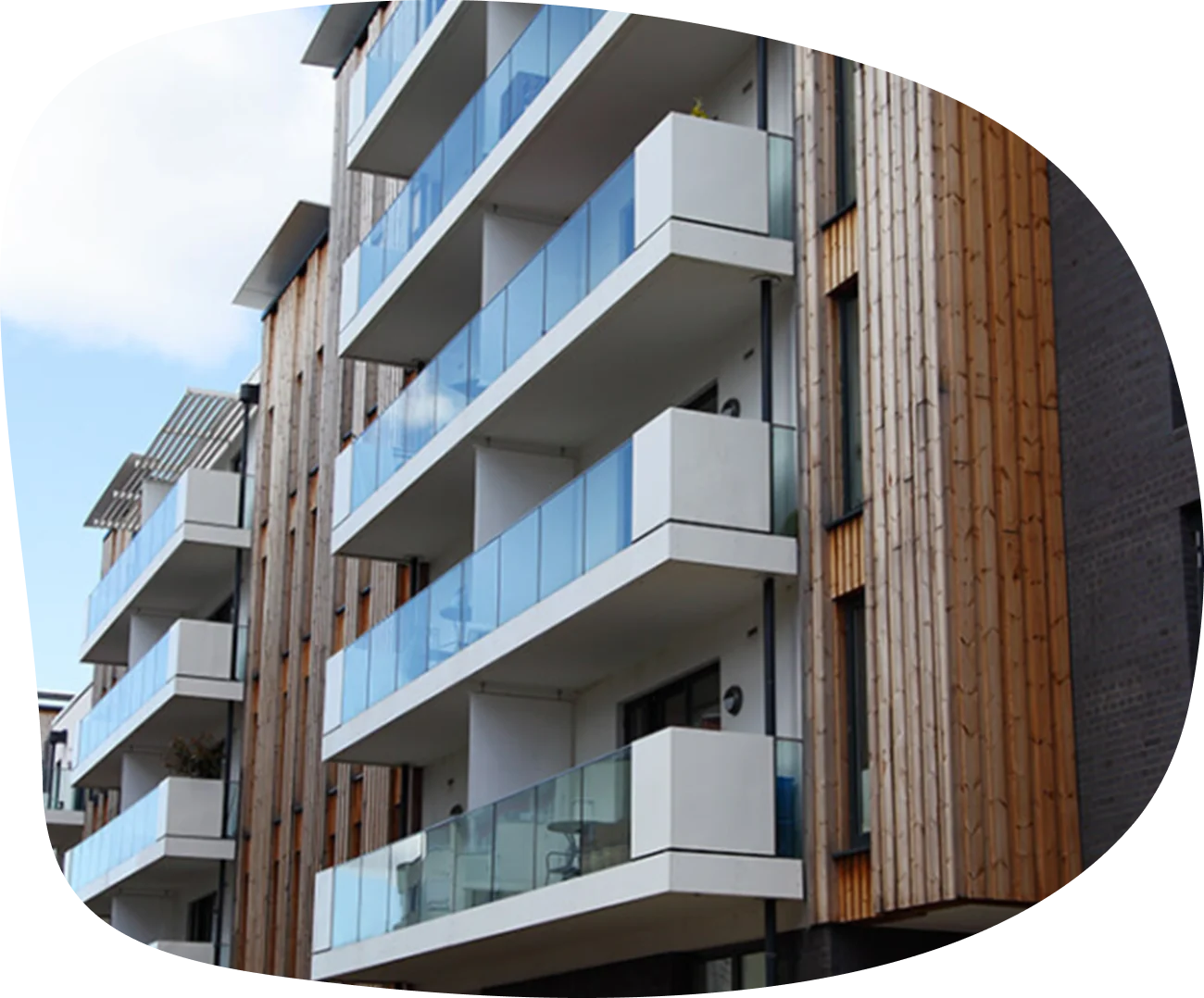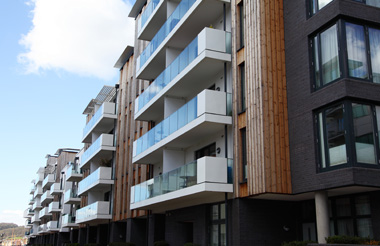Financing a Buy-to-Let HMO and UK Licensing Rules
Investing in an HMO property might seem like an attractive option yielding a higher rental income than standard buy-to-lets.


Financing a Buy-to-Let HMO and UK Licensing Rules
Taking out a buy-to-let mortgage HMO (house of multiple occupations) is the most common financing option when purchasing a multi-unit rental property. Although buy-to-let mortgage rates may be higher, the rental yields can be favourable and provide a viable investment opportunity for landlords with sufficient experience to operate compliantly as an HMO landlord.
The Financial Appeal of a Buy-to-Let Mortgage HMO
HMO properties are those with multiple units. One building that has three or more unrelated tenants who are not sharing accommodation and with shared communal facilities is normally considered an HMO.
When landlords access a buy-to-let mortgage profit calculator, they usually find that an HMO is a good investment prospect, with yields reaching as high as three times those available from individual rental properties. However, working with a buy-to-let mortgage broker may be increasingly important since the higher rental yields are coupled with more stringent regulatory standards and higher mortgage interest charges.
In this guide, Revolution Finance Brokers explain how a buy-to-let mortgage HMO product works, which properties it is suitable for, and what you should consider when comparing buy-to-let mortgage rates.
Property or loan details
Based on your details, you can borrow up to:
£0This calculator is an estimation of how much you could borrow. If you’re ready to take out a mortgage, speak to a Revolution brokers to see what options are available.
Securing a Buy-to-Let Mortgage for Your HMO Property
As we've mentioned, the buy-to-let mortgage rates available against HMO properties are costlier than for standalone buy-to-let purchases, but the benefit from a landlord's perspective is that they may be able to multiply their yields.
HMOs are commonly used as student accommodation or shared housing in more expensive cities, where steady demand from tenants means landlords can charge reasonable rental values while more than covering their buy-to-let HMO mortgage rates.
Before considering a buy-to-let mortgage HMO finance, the first step is to determine whether the property is indeed categorized as an HMO. This evaluation matters because local authorities can implement more robust rules for HMOs that are considered large, including mandatory licensing in some cases.
Licensing is there to ensure that all landlords who apply for buy-to-let HMO mortgages and manage multiple occupation property acts responsibly, providing quality housing that complies with all the safety standards to make an HMO safe and comfortable for the tenants.
In most cases, an HMO will be limited to three or more people, with one household treated as a couple or relatives in shared accommodation, with each household counted as one occupant. If the property has three or more tenants sharing kitchen and bathroom facilities, the residence is likely an HMO.
Navigating Licensing Rules Prior to Evaluating HMO Buy-to-Let Mortgage Rates
We recommend any landlord planning to invest in an HMO look at the localized licensing rules before they complete a buy-to-let HMO mortgage interest rates comparison. If a rental property is an HMO with three stories or above or has five or more separate tenants, it will normally be categorized as large.
That means HMO landlords will almost definitely need an HMO license – obtaining a permit may be necessary to secure approval for a buy-to-let mortgage HMO product.
Part of the reason buy-to-let mortgage rates for HMOs vary so greatly is that the specific rules differ between local councils. Some councils are significantly stricter and will require mandatory licensing for any HMO owner with five tenants or more. In contrast, others will apply more specific criteria depending on the nature and location of the property – this is referred to as selective licensing since discretion rests with the council.
It may, therefore, be easier and cheaper to choose a buy-to-let mortgage HMO product in one region or town over another. Buy-to-let mortgage rates may also be impacted by evidence of a license, where HMO mortgage lenders have the assurance that the landlord has already been approved.
HMO Licensing Costs
The costs of obtaining an HMO license are as diverse as the council policies. Some London boroughs can charge fees as varied as £120 to £2,500 for a similarly sized property – which could affect the mortgage options a buy-to-let mortgage broker recommends.
While those are among the highest and lowest licensing charges you are likely to experience, it is important to understand what local council approval will cost to factor this expense into a buy-to-let mortgage profit calculator.
HMO applications can also take varied times to process. If the council needs to investigate any aspect of the application related to the property or the landlord, this can be months rather than weeks before you are in a position to finalise a buy-to-let mortgage HMO agreement.
Licensing is typically renewed once every five years with costs payable per renewal, although landlords with multiple properties within the same area are normally offered discounted rates.
Licensing Terms Attached to a Buy-to-Let Mortgage HMO Agreement
As an overview, the below conditions are normally applied to determine whether a landlord will be permitted to act as an HMO landlord and how to obtain an HMO licence:
- The applicant must be considered ‘fit and proper' – i.e. without an unspent criminal conviction or previous convictions for breaches of property law or discrimination.
- Evidence of appropriate gas safety certification and confirmation that the furnishings and electrics within the property are safe.
- Proof that the property has working smoke alarms that are maintained.
- Verification that bedrooms meet minimum size requirements and tenants are provided with a written tenancy agreement.
- Confirmed compliance with waste disposal policies as implemented by the relevant council.
Landlords who purchase and operate an HMO that is subject to licensing, and are found to have breached the rules, can be fined up to £20,000, which may affect their eligibility for HMO buy-to-let mortgage rates.
How to Get a Buy-to-Let Mortgage for an HMO
Whether you have already been approved for an HMO license or are buying an exempt property, it is important you can cover the buy-to-let mortgage rates comfortably with the rental income generated by the HMO property.
The most viable investments tend to be properties close to key student or professional areas, such as homes near a university or hospital. Landlords should also research the area to ascertain what other landlords are charging and what the level of sustained tenancy demand is likely to be.
Conducting this research before applying for a buy-to-let mortgage HMO product is beneficial since the specialist HMO mortgage lenders will see sufficient evidence that the property is a good investment with little likelihood of prolonged vacancies and that the income will more than cover the buy-to-let mortgage rates.
Landlords hoping to add an HMO to their portfolios through a buy-to-let mortgage HMO product should also look at the following:
- The quality and condition of the property, where professional tenants will be far more inclined to rent a room in a shared home with excellent décor, gardens, and maintenance.
- Council tax obligations linked with the HMO.
- The potential for disputes between tenants, how the landlord will deal with these, and what they will do if one tenant wishes to exit their tenancy agreement early.
- Ongoing fire safety commitments, ensuring that HMOs remain safe with escape routes and fire extinguishing equipment.
Prospective HMO investors may also need to factor in projected tenant turnover when evaluating the available profit after paying buy-to-let mortgage rates. If tenants are expected to rent part of the property for a minimal period, this can cause increased costs and admin dealing with deposits and handovers between one tenant and the next.
The Advantages of Working With an HMO Mortgage Broker
With so many elements of HMO investment to work through, it is always a good idea to work with an experienced, independent buy-to-let specialist HMO mortgage broker with expertise in HMO properties. In general, an HMO mortgage lender are more agreeable to applicants with prior experience in managing an HMO, although some new landlords can obtain a buy-to-let mortgage HMO product if they are otherwise considered low risk.
The norm is for buy-to-let mortgage rates and deposit requirements for HMO acquisitions to be higher for landlords without at least one year of HMO management experience.
Buy-to-let mortgage HMO applicants who do not already own an HMO property are treated as first-time buyers, which can be a trickier proposition for a lender, who may consider a first-time investor and first-time buyer a much higher risk – attracting steeper buy-to-let mortgage rates.
Working through a buy-to-let mortgage profit calculator is crucial in these scenarios to ensure the rental income will still generate a decent return on the investment costs after repaying the monthly buy-to-let mortgage rates.
Smaller HMOs without a mandatory licensing requirement can be an easier option, and some lenders class these properties as multi-lets, which may also allow access to more competitive buy-to-let mortgage rates and a potentially lower buy-to-let mortgage deposit, depending on the other circumstances.
Property Valuations Against Buy-to-Let Mortgage HMO Applications
When you use an online buy-to-let mortgage rates comparison tool, you'll naturally be asked what the property is worth as a bricks-and-mortar asset and what it will generate in rental income. These figures help to work out whether buy-to-let mortgage rates are affordable and how easily the property returns will cover the financing costs.
The exact valuation process will depend on both the HMO and the lender because some will consider the property as a standalone investment, whereas others will be primarily interested in the rental yield.
If similar HMOs exist in the local area – which is likely for HMOs in student locations – a buy-to-let mortgage HMO lender may also consider the competitiveness of the property. If not, they are more likely to value HMO mortgages and the premise as a property, not a rental investment, which could mean you need a higher buy-to-let mortgage deposit to proceed.
This process differs between HMO mortgage brokers, and their policies are equally varied. For example, one lender might be happy to accept buy-to-let mortgage HMO applications for homes of any size, but another could only finance property investments if there are at most five bedrooms.
If you need independent help understanding how HMO mortgage specialists has valued a property before offering a buy-to-let mortgage HMO agreement, please get in touch with the Revolution team at any time to learn about the intricacies of an HMO mortgage market.
How To Secure Competitive Mortgage Rates on HMO Properties?
In the past, HMOs have been a highly specialized area of HMO lending, and it would have been very difficult indeed to negotiate a buy-to-let mortgage HMO agreement with a mainstream lender. However, as these shared homes have become more popular, a wider range of lenders are offering HMO products.
Somewhere around half of the UK lenders offering buy-to-let mortgage rates will consider an HMO, although there are fewer lenders than for standard buy-to-let property purchases.
Buy-to-let mortgage rates for HMOs are fairly similar to any other buy-to-let, but any risk factors or concerns can drive these rates significantly higher. Lenders have a far more complex task in assessing the licensing status of the experienced HMO landlord, their suitability as an HMO owner, and the financial returns available.
What is the maximum Borrowing Cap on HMO Financing?
The buy-to-let mortgage rates you are offered will depend on the loan-to-value – this is the proportion of the property purchase cost you are looking to finance through your selected lender. As a rough guide, most lenders will require a buy-to-let mortgage deposit of up to 40% on an HMO investment, and the higher the buy-to-let mortgage deposit you can offer, the lower your rates will be.
However, some buy-to-let mortgage HMO lenders will accept a lower down payment, provided the other risk factors are acceptable.
Should you require any further information about applying for buy-to-let mortgage HMO financing, understanding the licensing system, or crafting a strong application to secure the best possible buy-to-let mortgage rates, please get in touch with the Revolution Finance Brokers team at your convenience.
HMOs are similar to other buy-to-let properties. The primary difference is that an HMO has multiple tenants rather than one. These mortgage products are designed for a specific type of property and require a more in-depth affordability and eligibility assessment process.
The challenge is that tenants in an HMO are not related, so there is a higher prevalence of tenant turnovers and the potential for disputes between renters or for vacancies to arise when one tenant leaves.
However, an HMO can also be a fantastic investment. Landlords who navigate the licensing system can earn returns far greater than those available through individual rental properties, and benefit from high demand, particularly when renting to professionals within the commuter belt or students.
Buy-to-let mortgage rates on an HMO are higher than you may expect to pay on a typical rental property, and the costs of running and acquiring an HMO are also elevated. Every aspiring HMO landlord must understand the restrictions and licensing rules in place within their local area.
Lenders are less competitive when it comes to buy-to-let mortgage HMO applications because of the higher degree of uncertainty and because there are fewer lenders who are prepared to offer HMO products. Although competition is increasing, it’s important to work with an experienced buy-to-let mortgage broker to avoid paying more than necessary.
We’ve explained that lenders are more likely to approve a buy-to-let mortgage HMO applicant with previous experience or who has already been approved for an HMO licence if the property requires local authority licensing.
Landlords with at least one, and ideally three or more years of experience, are considered a safer bet because there is less likelihood they will default on their buy-to-let mortgage HMO payments or fail to comply with the regulations applied to HMO owners.
However, there are some lenders who will consider buy-to-let mortgage HMO applicants regardless of their professional experience, provided they comply with other eligibility requirements.
A buy-to-let mortgage rates comparison will show that deposit minimums vary depending on the lender, and your projected rental income, credit score, alternative income, property valuation and experience as a landlord.
Most lenders offering buy-to-let mortgage HMO products will expect a deposit of 40%, although some will accept a deposit of 25% or above if you satisfy all their other eligibility criteria and have a strong business case to support the acquisition.
Timescales on HMO lending can be longer than regular buy-to-lets. However, that, of course, depends on whether the property is subject to local licensing, whether you need to apply for mortgage financing, and how straightforward your application is.
In most cases, it takes around 12 weeks to arrange a buy-to-let mortgage HMO agreement, although that can vary considerably. If you need to modify the property, you will need to build this into the application timeframe.
That said, established HMOs with existing tenants or strong demand are much simpler to finance, and a mortgage agreement can be in place in as little as a month if the other circumstances do not pose any issues.
The standard fee depends on your area. For example, Bristol charges £1,420 for a new licence, compared to £1,330 in Nottingham and £2,330 in Oxford. Most councils will split the cost into two payments – one made when you apply, and the balance on approval before your licence is issued.
Licensing costs for a much larger HMO with ten or more rooms are higher, with an uplift on every unit. The cap on licensing charges is £6,000, but only the most extensive multi-unit properties will cost close to this value to licence.
Most landlords with an HMO property with five tenants or more with at least one rental income stream and shared kitchen or bathroom facilities will need a licence, and a lender will consider this when deciding whether they can make an offer to lend against a buy-to-let mortgage HMO product.
Licences are normally renewable after five years, so a lender will include this recurring cost in their calculations to assess whether they believe the mortgage is affordable and viable.
HMO lenders will often ask for confirmation of the licensing before finalising an offer, which helps them verify whether the landlord is compliant with all the safety rules. For example, a landlord needs to ensure the property has appropriate fire safety provisions such as escape routes, fire doors, and extinguishers, increasing with the number of tenants.
They may also be asked to confirm the maximum number of total tenants, depending on the size of the HMO. Specific restrictions apply to the size of the bedroom, the capacity of kitchen, bathroom and toilet facilities, and the floor space in the total property.
Smaller HMOs intended to accommodate multiple tenants can be harder to finance if the lender or local council believes the conditions may be overcrowded.
Further Reading
-
Financing a Buy-to-Let HMO and UK Licensing Rules
-
LTD Company Property Finance
-
Property Refurbishment Finance
-
Buy To Let Mortgages for Expats
-
Buy To Let Refurbishment Mortgages
-
Portfolio Landlord Mortgages
-
Buy to Let Interest-Only Mortgages
-
Changing Your Mortgage to Buy to Let
-
Mortgages for Buy to Sell Investments
-
Company Mortgages for SPVs
-
Stamp Duty for Buy to Let
-
Repayment Mortgage for Buy to Let
-
Buy To Let Mortgages For New Builds
-
Buy To Let Mortgages For Retiree Landlords
-
Buy To Let Mortgage With Poor Credit
-
Securing BTL Mortgage Quotes & BTL Agreement
-
BTL UK Portfolio Mortgages
-
Best Buy to Let Mortgages: 75% LTV
-
Buy to let 80% LTV Mortgages
-
Holiday Let Mortgages
-
Buy to Let Remortgage
-
Buy to Let Mortgages Guide for Investors
-
Let to Buy
-
Applying for a Buy-to-Let Mortgage Without a Minimum Income
Explore Our Presence
Securing an excellent mortgage offer with Revolution Finance
Brokers couldn't be easier:
Revolution Mortgage Brokers:
100% Independent & Whole-of-Market
As specialist mortgage brokers for a huge variety of applicants, the whole-of-market consultants at Revolution provide access to an exceptional range of lenders, products and mortgage deals. That means you get the advantage of professional negotiation and broker-exclusives through an established lending network to ensure we always find you the most competitive mortgage available.
Ask the Expert
Mortgage Brokers


























